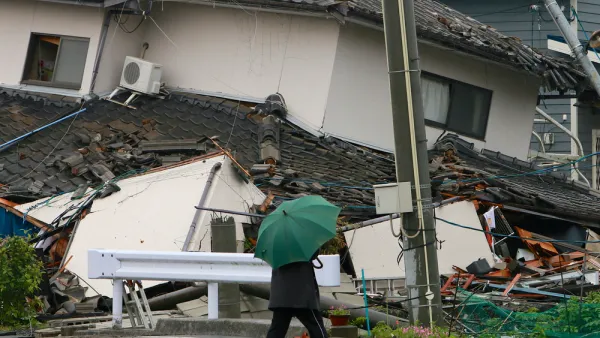Christopher Hawthorne reports from Japan on the many obstacles preventing areas destroyed by the Tōhoku earthquake and tsunami from proceeding with rebuilding, as the recovery effort stalls in the cleanup stage.
Although northeastern Japan has made enormous strides in removing the astonishing amount of debris caused by last year's disaster, Hawthorne outlines the leadership and political roadblocks that have prevented communities from starting in earnest on substantial construction efforts, as some of the largest questions regarding rebuilding go unanswered.
According to Hawthorne, "Prime Minister Yoshihiko Noda, his approval rating in danger of sinking below 30%, has faced wide criticism for failing to articulate a broad vision for rebuilding. The national Reconstruction Agency wasn't officially launched until February, 11 months after the disaster...The most intractable issue is whether the hardest hit fishing villages, already losing population before the disaster, should be rebuilt as they were or consolidated." Larger socio-economic fault lines have also been exposed by the earthquake, and these issues must be discussed as they are likely to guide rebuilding plans.
The lack of progress on rebuilding is not for lack of trying by the country's architects and planners who have worked diligently with local communities to develop plans for reconstruction.
While a larger vision for recovery goes unarticulated, local communities have also struggled to develop consensus on how to rebuild their towns. "Sharp disagreement" amongst local residents and politicians "over reconstruction goals has repeated itself in the smaller towns along the Oshika Peninsula," according to Hawthorne. And "the lack of consensus on basic issues calls into question precisely how" $3.75 billion in rebuilding grants recently approved by the central government will be spent.
FULL STORY: Japan Disaster: A Year Later: Without a blueprint

Analysis: Cybertruck Fatality Rate Far Exceeds That of Ford Pinto
The Tesla Cybertruck was recalled seven times last year.

National Parks Layoffs Will Cause Communities to Lose Billions
Thousands of essential park workers were laid off this week, just before the busy spring break season.

Retro-silient?: America’s First “Eco-burb,” The Woodlands Turns 50
A master-planned community north of Houston offers lessons on green infrastructure and resilient design, but falls short of its founder’s lofty affordability and walkability goals.

Test News Post 1
This is a summary

Analysis: Cybertruck Fatality Rate Far Exceeds That of Ford Pinto
The Tesla Cybertruck was recalled seven times last year.

Test News Headline 46
Test for the image on the front page.
Urban Design for Planners 1: Software Tools
This six-course series explores essential urban design concepts using open source software and equips planners with the tools they need to participate fully in the urban design process.
Planning for Universal Design
Learn the tools for implementing Universal Design in planning regulations.
EMC Planning Group, Inc.
Planetizen
Planetizen
Mpact (formerly Rail~Volution)
Great Falls Development Authority, Inc.
HUDs Office of Policy Development and Research
NYU Wagner Graduate School of Public Service


























